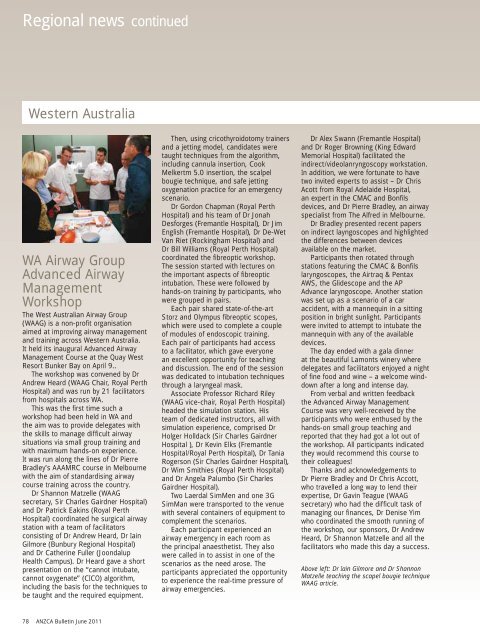ANZCA Bulletin June 2011 - Australian and New Zealand College of ...
ANZCA Bulletin June 2011 - Australian and New Zealand College of ...
ANZCA Bulletin June 2011 - Australian and New Zealand College of ...
You also want an ePaper? Increase the reach of your titles
YUMPU automatically turns print PDFs into web optimized ePapers that Google loves.
Regional news continued<br />
Western Australia<br />
WA Airway Group<br />
Advanced Airway<br />
Management<br />
Workshop<br />
The West <strong>Australian</strong> Airway Group<br />
(WAAG) is a non-pr<strong>of</strong>i t organisation<br />
aimed at improving airway management<br />
<strong>and</strong> training across Western Australia.<br />
It held its inaugural Advanced Airway<br />
Management Course at the Quay West<br />
Resort Bunker Bay on April 9..<br />
The workshop was convened by Dr<br />
Andrew Heard (WAAG Chair, Royal Perth<br />
Hospital) <strong>and</strong> was run by 21 facilitators<br />
from hospitals across WA.<br />
This was the fi rst time such a<br />
workshop had been held in WA <strong>and</strong><br />
the aim was to provide delegates with<br />
the skills to manage diffi cult airway<br />
situations via small group training <strong>and</strong><br />
with maximum h<strong>and</strong>s-on experience.<br />
It was run along the lines <strong>of</strong> Dr Pierre<br />
Bradley’s AAAMRC course in Melbourne<br />
with the aim <strong>of</strong> st<strong>and</strong>ardising airway<br />
course training across the country.<br />
Dr Shannon Matzelle (WAAG<br />
secretary, Sir Charles Gairdner Hospital)<br />
<strong>and</strong> Dr Patrick Eakins (Royal Perth<br />
Hospital) coordinated he surgical airway<br />
station with a team <strong>of</strong> facilitators<br />
consisting <strong>of</strong> Dr Andrew Heard, Dr Iain<br />
Gilmore (Bunbury Regional Hospital)<br />
<strong>and</strong> Dr Catherine Fuller (Joondalup<br />
Health Campus). Dr Heard gave a short<br />
presentation on the “cannot intubate,<br />
cannot oxygenate” (CICO) algorithm,<br />
including the basis for the techniques to<br />
be taught <strong>and</strong> the required equipment.<br />
Then, using cricothyroidotomy trainers<br />
<strong>and</strong> a jetting model, c<strong>and</strong>idates were<br />
taught techniques from the algorithm,<br />
including cannula insertion, Cook<br />
Melkertm 5.0 insertion, the scalpel<br />
bougie technique, <strong>and</strong> safe jetting<br />
oxygenation practice for an emergency<br />
scenario.<br />
Dr Gordon Chapman (Royal Perth<br />
Hospital) <strong>and</strong> his team <strong>of</strong> Dr Jonah<br />
Desforges (Fremantle Hospital), Dr Jim<br />
English (Fremantle Hospital), Dr De-Wet<br />
Van Riet (Rockingham Hospital) <strong>and</strong><br />
Dr Bill Williams (Royal Perth Hospital)<br />
coordinated the fi breoptic workshop.<br />
The session started with lectures on<br />
the important aspects <strong>of</strong> fi breoptic<br />
intubation. These were followed by<br />
h<strong>and</strong>s-on training by participants, who<br />
were grouped in pairs.<br />
Each pair shared state-<strong>of</strong>-the-art<br />
Storz <strong>and</strong> Olympus fi breoptic scopes,<br />
which were used to complete a couple<br />
<strong>of</strong> modules <strong>of</strong> endoscopic training.<br />
Each pair <strong>of</strong> participants had access<br />
to a facilitator, which gave everyone<br />
an excellent opportunity for teaching<br />
<strong>and</strong> discussion. The end <strong>of</strong> the session<br />
was dedicated to intubation techniques<br />
through a laryngeal mask.<br />
Associate Pr<strong>of</strong>essor Richard Riley<br />
(WAAG vice-chair, Royal Perth Hospital)<br />
headed the simulation station. His<br />
team <strong>of</strong> dedicated instructors, all with<br />
simulation experience, comprised Dr<br />
Holger Holldack (Sir Charles Gairdner<br />
Hospital ), Dr Kevin Elks (Fremantle<br />
Hospital/Royal Perth Hospital), Dr Tania<br />
Rogerson (Sir Charles Gairdner Hospital),<br />
Dr Wim Smithies (Royal Perth Hospital)<br />
<strong>and</strong> Dr Angela Palumbo (Sir Charles<br />
Gairdner Hospital).<br />
Two Laerdal SimMen <strong>and</strong> one 3G<br />
SimMan were transported to the venue<br />
with several containers <strong>of</strong> equipment to<br />
complement the scenarios.<br />
Each participant experienced an<br />
airway emergency in each room as<br />
the principal anaesthetist. They also<br />
were called in to assist in one <strong>of</strong> the<br />
scenarios as the need arose. The<br />
participants appreciated the opportunity<br />
to experience the real-time pressure <strong>of</strong><br />
airway emergencies.<br />
Dr Alex Swann (Fremantle Hospital)<br />
<strong>and</strong> Dr Roger Browning (King Edward<br />
Memorial Hospital) facilitated the<br />
indirect/videolanryngoscopy workstation.<br />
In addition, we were fortunate to have<br />
two invited experts to assist – Dr Chris<br />
Acott from Royal Adelaide Hospital,<br />
an expert in the CMAC <strong>and</strong> Bonfi ls<br />
devices, <strong>and</strong> Dr Pierre Bradley, an airway<br />
specialist from The Alfred in Melbourne.<br />
Dr Bradley presented recent papers<br />
on indirect layngoscopes <strong>and</strong> highlighted<br />
the differences between devices<br />
available on the market.<br />
Participants then rotated through<br />
stations featuring the CMAC & Bonfi ls<br />
laryngoscopes, the Airtraq & Pentax<br />
AWS, the Glidescope <strong>and</strong> the AP<br />
Advance laryngoscope. Another station<br />
was set up as a scenario <strong>of</strong> a car<br />
accident, with a mannequin in a sitting<br />
position in bright sunlight. Participants<br />
were invited to attempt to intubate the<br />
mannequin with any <strong>of</strong> the available<br />
devices.<br />
The day ended with a gala dinner<br />
at the beautiful Lamonts winery where<br />
delegates <strong>and</strong> facilitators enjoyed a night<br />
<strong>of</strong> fi ne food <strong>and</strong> wine – a welcome winddown<br />
after a long <strong>and</strong> intense day.<br />
From verbal <strong>and</strong> written feedback<br />
the Advanced Airway Management<br />
Course was very well-received by the<br />
participants who were enthused by the<br />
h<strong>and</strong>s-on small group teaching <strong>and</strong><br />
reported that they had got a lot out <strong>of</strong><br />
the workshop. All participants indicated<br />
they would recommend this course to<br />
their colleagues!<br />
Thanks <strong>and</strong> acknowledgements to<br />
Dr Pierre Bradley <strong>and</strong> Dr Chris Accott,<br />
who travelled a long way to lend their<br />
expertise, Dr Gavin Teague (WAAG<br />
secretary) who had the diffi cult task <strong>of</strong><br />
managing our fi nances, Dr Denise Yim<br />
who coordinated the smooth running <strong>of</strong><br />
the workshop, our sponsors, Dr Andrew<br />
Heard, Dr Shannon Matzelle <strong>and</strong> all the<br />
facilitators who made this day a success.<br />
Above left: Dr Iain Gilmore <strong>and</strong> Dr Shannon<br />
Matzelle teaching the scapel bougie technique<br />
WAAG article.<br />
78<br />
<strong>ANZCA</strong> <strong>Bulletin</strong> <strong>June</strong> <strong>2011</strong>

















